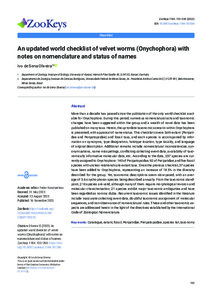| dcterms.abstract | More than a decade has passed since the publication of the only world checklist available for Onychophora. During this period, numerous nomenclatural acts and taxonomic changes have been suggested within the group and a wealth of novel data has been published on many taxa. Herein, the up-to-date taxonomic scenario within Onychophora is presented, with appraisal of name status. This checklist covers both extant (Peripatidae and Peripatopsidae) and fossil taxa, and each species is accompanied by information on synonyms, type designation, holotype location, type locality, and language of original description. Additional remarks include nomenclatural inconsistencies, synonymizations, name misspellings, conflicting collecting event data, availability of taxonomically informative molecular data, etc. According to the data, 237 species are currently assigned to Onychophora: 140 of Peripatopsidae, 92 of Peripatidae, and five fossil species with unclear relationship to extant taxa. Since the previous checklist, 37 species have been added to Onychophora, representing an increase of 18.5% in the diversity described for the group. Yet, taxonomic descriptions seem slow-paced, with an average of 3.6 onychophoran species being described annually. From the taxonomic standpoint, 216 species are valid, although many of them require morphological revision and molecular characterization; 21 species exhibit major taxonomic ambiguities and have been regarded as nomina dubia. Recurrent taxonomic issues identified in the literature include inaccurate collecting event data, doubtful taxonomic assignment of molecular sequences, and non-observance of nomenclatural rules. These and other taxonomic aspects are addressed herein in the light of the directives established by the International Code of Zoological Nomenclature. | eng |


